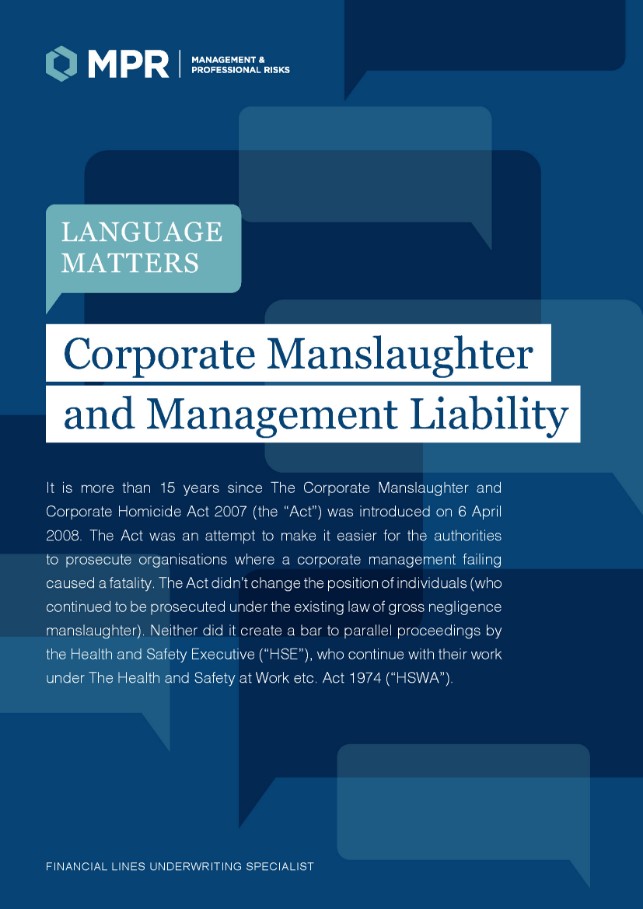It is more than 15 years since The Corporate Manslaughter and Corporate Homicide Act 2007 (the “Act”) was introduced on 6 April 2008. The Act was an attempt to make it easier for the authorities to prosecute organisations where a corporate management failing caused a fatality. The Act didn’t change the position of individuals (who continued to be prosecuted under the existing law of gross negligence manslaughter). Neither did it create a bar to parallel proceedings by the Health and Safety Executive (“HSE”), who continue with their work under The Health and Safety at Work etc. Act 1974 (“HSWA”).
There can be little doubt that prosecutions under the Act have not been as widespread as might have been anticipated. Even when an organisation is put on trial, a conviction is unlikely. At the time of writing, only 26 convictions have been secured, which is less than 2 per year. There is an argument that the profile of the law and the emphasis placed on the punishments have played a part in the general improvement in these statistics (in 2021/22, there were 123 work place related deaths versus 247 in 2006/07, around the time the Act was about to be introduced). Nonetheless, charging an organisation for corporate manslaughter requires the Crown Prosecution Service (“CPS”) to expend time and resources. In the case of Lion Steel Equipment Limited (“Lion Steel”), where a worker fell to his death through a fragile roof panel, it was estimated to have cost £140,000 to secure the conviction. An interesting component of that case was the willingness of the CPS to bring charges against individual directors, which in turn potentially put pressure on the corporate entity to plead guilty, highlighting a potential conundrum for directors. A director could be in breach of a duty to the organisation if they are acting in their own best interests but the prospect of a possible custodial sentence (gross negligence manslaughter has a maximum tariff of life imprisonment) could make a director feel vulnerable enough to prioritise their personal position over that of the organisation.
The CPS empowers the HSE to prosecute and there is a balance to be made with the economic risk of prosecution and the greater chance of conviction under health and safety law. Two of the largest companies to be convicted under the Act (Geotechnical Holdings Ltd and Lion Steel) were still relatively small and it was because the management had not taken steps to protect employees that the convictions were secured. Had they had more complex management structures, they may have escaped conviction because of the difficulty of identification of management failings, and this clearly cannot have been the intention behind the Act. With stricter liability attaching to many offences under the HSWA, they are evidentially easier to prove and this may drive more prosecutions down that route.
As is common in many scenarios, contracts of insurance can overlap, and this is the case with General Liability (“GL”) covers (Public Liability and Employers Liability) and Management Liability (“ML”). Many GL insurers will provide legal protection under a ‘Defence of Legal Rights’ provision or similar. This will include cover for ‘Insured’s Persons’ being prosecuted in a criminal court, or a formal investigation or disciplinary hearing brought against an Insured Person (all employees) by a regulatory body. The view from D&O lawyers is often more straightforward, and that is that GL will cover the organisation, whilst D&O is fundamentally designed to cover the management team for their breaches of duties and actual/alleged wrongful acts. Whilst that works in theory, it rarely seems to be this clear cut. To complicate matters further, the emergence of Corporate Legal Liability (“CLL”) as an extension to ML policies has further blurred these lines. It is therefore no surprise to sometimes see a tug of war taking place between insurers, particularly whilst a decision is made on whether (and who) to prosecute. One of the stronger arguments is around the GL being the more specific cover, a position supported by the standard position on the ML contract to exclude claims ‘for’ bodily injury. Nonetheless, there is no neat and convenient dovetail and much will depend on both the pattern of facts and on the respective quality of the GL and ML contracts.
From a ML perspective, the position has not fundamentally changed for many years. The statistical risk to managers remains low but an accident can expose directors to a long period of anxiety and hefty fines (which insurance is not allowed to pay). Affirmative cover will provide up to £250,000 defence costs cover for claims against the organisation for corporate manslaughter. This is in addition to defence costs cover for claims against individuals as a result of criminal proceedings for manslaughter. The policies also provide cover for costs associated with Health and Safety investigations against the organisation and insured persons (as defined). Ultimately, however, there is no clearly marked roadmap for the route that a claim should or will take so it is practically impossible to capture a defined or standardised position.


